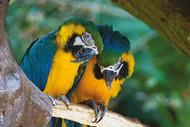Blue & Gold Macaw Fact Sheet
Posted by Blue and Gold Macaw facts, Parrot facts, what to feed a Blue and Gold Macaw on 9/1/2024
Rosemary Low explains more about the Blue and Gold Macaw.
Scientific name:
Ara ararauna
Common name:

Click here for everything you need for Blue and Gold Macaws.
Adult length:
86cm-92cm (34-36in)
Adult wingspan:
about 1.1m (42in)
Adult weight:
males approximately one kilo but up to 1,200g; females about 930g.
Potential lifespan:
60 years.

Origin:
Widely distributed over tropical (northern) South America, also Panama and Central America.
Status in wild:
Common in areas of good habitat where no trapping occurs. It has declined or disappeared from many areas near human habitation and where drastic deforestation has occurred, such as coastal Brazil.
SUITABILITY
According to figures published in 2010, over 20 million pets are kept in Britain, a figure which has been increasing steadily for decades. If it is true that we have become even more addicted to pets, it is also true that bad choices are made. For the average household a large Macaw would be a bad choice.
Several months ago a friend who keeps several Parrots as companions, including two Macaws, was approached by a man who asked him to take his Blue and Yellow Macaw. I will not distress readers by recounting what he proposed to do with it if my friend said no, only that he said at once he would take it ? although he did not need another Macaw in the house.
The Macaw turned out to be no trouble at all. He appeared to be an old, wild-caught bird who could not fly. He sits on his stand all day, not interacting with the other birds, not playing with toys and not screaming. At last he has found a peaceful, caring home where he is offered a varied and nutritious diet.
Several months after acquiring the Macaw, my friend encountered the man with his little granddaughter. She asked after the Macaw, adding: ?Does he still scream a lot? Grandad used to throw his shoe at him when he screamed, didn?t you, Grandad?? The man did not reply.
The unfortunate Macaw had lived in an atmosphere of fear and violence. It could not fly and to have a shoe hurled at it must have been terrifying. Sadly, there is nothing unusual about this story. Many purchasers of young Macaws have no notion that these large Parrots need special, caring owners, because they are not easy to live with, because they are demanding, loud and destructive.
BUYING

Buy only from a reputable, established breeder who will not sell a young Macaw of a large species before 20 weeks. They are seldom fully weaned before this age. Too many young Macaws have a disastrous start in life because they are sold too young, without instructions to continue hand-feeding as long as the bird requires it.
ACCOMMODATION
If, after careful consideration, you believe that a large Macaw could fit into your household, buy the largest suitable cage you can afford, which will probably cost at least ?800. In addition, build an aviary where, starting in mild weather, your Macaw can have quality time outdoors, safely having access to sun (with adequate roof cover) and rain.
This will add another dimension to your Macaw?s life and make him or her easier to live with. It will also add greatly to the cost. In some countries in Europe, legislation stipulates the minimum size accommodation for a Macaw, recognising how wrong it is to keep these large birds closely confined. It seems to be a long time coming but eventually it will happen here.
Here are our choice of Blue and Gold Macaw cages.
DIET
This Macaw might be described as omnivorous as it is very willing to sample most kinds of foods. Because its natural diet includes a large percentage of high-fat fruits from palm trees, a diet high in the kind of lipids found in walnuts, pecans, Brazil nuts and macadamia is important.
In Parrots which easily become obese, such as Amazons, it is wrong to feed sunflower seed in quantity. This is not true of the Blue and Yellow Macaw. It needs a good quality seed mixture (large Macaws also eat small seeds) without such pointless additions as hard maize, flaked peas and pieces of dried fruit. Fresh fruit and vegetables should be offered on a daily basis, especially those high in Vitamin A (broccoli, red bell pepper, whole dandelion plants).
Favourite fruits are orange (sweet), pomegranate and grapes. It is not harmful to offer cooked meat, including the bone, as long as no small sharp bones are present. Young birds should be offered soft foods such as warm, cooked pasta and wholegrain bread soaked in a little honey water for as long as they want it.
For Blue and Gold Macaw food please click here.

PLUMAGE CARE
Large Macaws (except those recently weaned) need access to water ? either being allowed to bathe in the sink or the shower or by being sprayed with warm water from a plant mister, several times a week. This is especially important for birds kept in centrally heated rooms. These Macaws come from areas of high humidity. They an suffer from skin conditions that could result in feather plucking if kept in dry locations.
For everything you need for Blue and Gold Macaws please click here.

